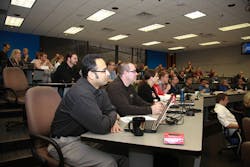Three men were stranded on a desert island. They had been there all alone for five years when one day a magic lantern washed up on the beach. One of them rubbed the lamp, and a genie popped out and said, “Thank you for releasing me! For your kind deed, I will grant each of you one wish.”
The first man said, “Oh boy! This is my big chance! I want to live on Wall Street and be fabulously successful in finance. I want to have all the luxuries money can buy, like a big mansion, a yacht, a jet airplane and a limousine with a chauffeur. And I also want to have my picture on Time magazine.”
The Genie said, “As you wish.” And, poof, the man was gone.
The second man said, “Yeah! I want to go to Hollywood and be a famous actor and have lots of money and lots of girlfriends, and I want a limousine and chauffeur just like the other guy, and I want to win an Oscar and be on late-night TV.”
Again, the genie said, “As you wish.” And, poof, the second man was gone.
Then the genie said to the third man, “And what is your wish?”
The third man said, “I miss those other two guys. I wish they were back here.”
Our dilemma is that we hate change and love it at the same time; what we really want is for things to remain the same, but get better.
Somewhere back in your past, you made a conscious decision to get into this industry. Following that decision, somewhere or somehow you got some training so that you could be competent in this industry. Maybe you attended a vocational school or a college to jumpstart your career. Or maybe you took many classes over a long period of time to bring you up to where you are today. Or maybe you entered one of the many trade apprenticeships.
For many of us, this is a never-ending journey of learning, then applying, then learning, then applying… throughout your career. Ongoing training is just a natural component of our lives.
But maybe you have been in the industry for a couple of decades and you have reached a plateau where there just isn’t anything that important that you need to learn to change your business model. You are as successful as you want to be. You are comfortable. Congratulations! You have arrived at the corner of “Status Quo” and “Ill-Conceived” Security.
The problem is, your competitor didn’t stop. It isn’t that you are no longer qualified; it is that your competitor is now more qualified. He now has more tools in his toolbox, and this converts to jobs. And it’s not just one or two competitors; it is the whole industry. It is always in an evolutionary growth mode.
“Learning is a little like rowing upstream; as soon as you stop, you are going backwards.”
I am passionate about growth. Having said that, I don’t necessarily subscribe to the thought, “If you’re not growing, you’re dying.” Certainly, growth is a component of business, but it is not the only component; nor is it always the most important component. Sometimes it is advantageous to postpone growth to allow resources to catch up to you. Sometimes it makes sense to dial down growth until certain talents or skills are acquired.
Long term, however, growth must certainly be a strategy in your business plan simply because your competitors are doing it. And training is a key component of growth. But as important as training is, it is also critical to know when to use it and when not to use it. This is where a veteran contractor really shows what he or she is made of.
A case study in this very concept is Murray Pound, the owner of Gold Seal Homes in Alberta, Canada. Several years ago, Murray was introduced to fire sprinkler systems in homes, and he really bought into the safety aspect of these products. During that time, 100 percent of the homes that Murray built were fitted with fire sprinklers. It wasn’t just an option, like granite countertops; it was part of the deal. As a contractor and builder, he was a champion for fire sprinklers when almost everyone else in his industry was pushing back. But during that time, his business flourished. The potential buyers saw Murray’s company as one that championed their safety.
But the story doesn’t end there. Along came the downturn in the Alberta oil fields that changed the economy from good, steady growth to a substantial cut in new home sales almost overnight. Today, contractors are struggling to keep their businesses going. The inventory of new houses has increased to the point of slowing new construction to a crawl. And Murray has been around long enough to know that you don’t push technology when you are struggling to survive.
I talked to Murray last week and he told me that one day the economy will return and fire safety systems will be desired, and “me and my plumbers will be ready to handle the new business where others will be struggling to learn.” To me, that is how an industry veteran stays ahead. He not only knows the information, but he knows when to use it. Timing is a large part of training.
The problem with technology is “You don’t know what you don’t know.” And what you don’t know can harm your business or career.
Technology is not just a collection of equipment. It has now become an essential piece of your business process. You are probably using many pieces of current technology today, but almost always, it is underutilized or used incorrectly. I would like to suggest the following as a pathway to maximize the efficiency of your technology.
No. 1 – Audit: Audit what technology you currently have and what technology is being used in your industry. Magazines such as CONTRACTOR are a great starting point for finding new technology. Manufacturers’ websites are another great resource. Concerning your current technology, go to various manufacturers’ sites and download their manuals. You will be amazed at what you didn’t know.
No. 2 – Evaluate: Prioritize the new technology that you find and pick one or two to focus on. Before making any purchases, get to know how they work and why they work. As a result, you will be much more likely to use them because you will be familiar with them. Make sure whatever technology you are thinking about adding will actually be a positive move in the right direction. There is the story of a man who went to get his brakes fixed and when he got his car back, the mechanic said to him, “I couldn’t fix your brakes, so I made your horn louder.” Not exactly the kind of technology increase we are talking about. Any additional technology that you are considering must first be relevant.
No. 3 – Implement: This means to apply the new technology in a manner consistent with its original design or purpose. Many technologies fail because we are using them for the wrong application. If the only tool you have is a hammer, you tend to see all problems as a nail.
No. 4 – Integrate: Now we take the technology that we have implemented and we incorporate it into our day-to-day business.
For the past four decades, I have made sure that every two years I attend some kind of training for my industry. I have been to pump schools, boiler schools, control schools, wiring classes, hydronic equipment schools and any other opportunity that would help me get ahead. Check out the training that IAPMO is producing. It is amazing!
Training and new technology offer you several advantages. They provide you with a distinction or a difference between you and your competition. They also increase competitiveness because you are able to boost the number of applications your company is capable of producing. Remember, you can’t export what you don’t manufacture. Training and new technology also help you reduce the amount of “selling” that you need to do with your customer. Value-added increases in your abilities make it much easier for your customers to say “yes.”
“Faced with the choice between changing one’s mind and proving that there is no need to do so, almost everyone gets busy on the proof.” — John Kenneth Galbraith
So jump in the DeLorean (à la “Back to the Future”) and come back to the future. Grab a piece of training and go with it.
I would be grateful to hear your thoughts, ideas and stories.
Until then, best regards and happy heating.
Steve Swanson is the customer trainer at Uponor Academy. He actively welcomes reader comments and can be reached at [email protected].




